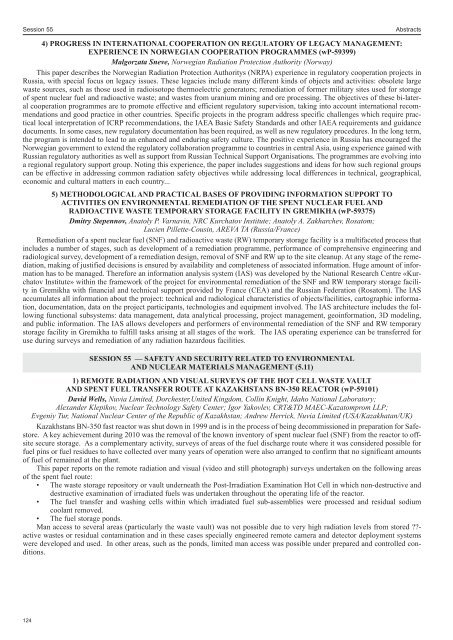ICEM11 Final Program 9.7.11pm_ICEM07 Final Program ... - Events
ICEM11 Final Program 9.7.11pm_ICEM07 Final Program ... - Events
ICEM11 Final Program 9.7.11pm_ICEM07 Final Program ... - Events
Create successful ePaper yourself
Turn your PDF publications into a flip-book with our unique Google optimized e-Paper software.
Session 55 Abstracts<br />
4) PROGRESS IN INTERNATIONAL COOPERATION ON REGULATORY OF LEGACY MANAGEMENT:<br />
EXPERIENCE IN NORWEGIAN COOPERATION PROGRAMMES (wP-59399)<br />
Malgorzata Sneve, Norwegian Radiation Protection Authority (Norway)<br />
This paper describes the Norwegian Radiation Protection Authoritys (NRPA) experience in regulatory cooperation projects in<br />
Russia, with special focus on legacy issues. These legacies include many different kinds of objects and activities: obsolete large<br />
waste sources, such as those used in radioisotope thermoelectric generators; remediation of former military sites used for storage<br />
of spent nuclear fuel and radioactive waste; and wastes from uranium mining and ore processing. The objectives of these bi-lateral<br />
cooperation programmes are to promote effective and efficient regulatory supervision, taking into account international recommendations<br />
and good practice in other countries. Specific projects in the program address specific challenges which require practical<br />
local interpretation of ICRP recommendations, the IAEA Basic Safety Standards and other IAEA requirements and guidance<br />
documents. In some cases, new regulatory documentation has been required, as well as new regulatory procedures. In the long term,<br />
the program is intended to lead to an enhanced and enduring safety culture. The positive experience in Russia has encouraged the<br />
Norwegian government to extend the regulatory collaboration programme to countries in central Asia, using experience gained with<br />
Russian regulatory authorities as well as support from Russian Technical Support Organisations. The programmes are evolving into<br />
a regional regulatory support group. Noting this experience, the paper includes suggestions and ideas for how such regional groups<br />
can be effective in addressing common radiation safety objectives while addressing local differences in technical, geographical,<br />
economic and cultural matters in each country...<br />
5) METHODOLOGICAL AND PRACTICAL BASES OF PROVIDING INFORMATION SUPPORT TO<br />
ACTIVITIES ON ENVIRONMENTAL REMEDIATION OF THE SPENT NUCLEAR FUEL AND<br />
RADIOACTIVE WASTE TEMPORARY STORAGE FACILITY IN GREMIKHA (wP-59375)<br />
Dmitry Stepennov, Anatoly P. Varnavin, NRC Kurchatov Institute; Anatoly A. Zakharchev, Rosatom;<br />
Lucien Pillette-Cousin, AREVA TA (Russia/France)<br />
Remediation of a spent nuclear fuel (SNF) and radioactive waste (RW) temporary storage facility is a multifaceted process that<br />
includes a number of stages, such as development of a remediation programme, performance of comprehensive engineering and<br />
radiological survey, development of a remediation design, removal of SNF and RW up to the site cleanup. At any stage of the remediation,<br />
making of justified decisions is ensured by availability and completeness of associated information. Huge amount of information<br />
has to be managed. Therefore an information analysis system (IAS) was developed by the National Research Centre «Kurchatov<br />
Institute» within the framework of the project for environmental remediation of the SNF and RW temporary storage facility<br />
in Gremikha with financial and technical support provided by France (CEA) and the Russian Federation (Rosatom). The IAS<br />
accumulates all information about the project: technical and radiological characteristics of objects/facilities, cartographic information,<br />
documentation, data on the project participants, technologies and equipment involved. The IAS architecture includes the following<br />
functional subsystems: data management, data analytical processing, project management, geoinformation, 3D modeling,<br />
and public information. The IAS allows developers and performers of environmental remediation of the SNF and RW temporary<br />
storage facility in Gremikha to fulfill tasks arising at all stages of the work. The IAS operating experience can be transferred for<br />
use during surveys and remediation of any radiation hazardous facilities.<br />
SESSION 55 — SAFETY AND SECURITY RELATED TO ENVIRONMENTAL<br />
AND NUCLEAR MATERIALS MANAGEMENT (5.11)<br />
1) REMOTE RADIATION AND VISUAL SURVEYS OF THE HOT CELL WASTE VAULT<br />
AND SPENT FUEL TRANSFER ROUTE AT KAZAKHSTANS BN-350 REACTOR (wP-59101)<br />
David Wells, Nuvia Limited, Dorchester,United Kingdom, Collin Knight, Idaho National Laboratory;<br />
Alexander Klepikov, Nuclear Technology Safety Center; Igor Yakovlev, CRT&TD MAEC-Kazatomprom LLP;<br />
Evgeniy Tur, National Nuclear Center of the Republic of Kazakhstan; Andrew Herrick, Nuvia Limited (USA/Kazakhatan/UK)<br />
Kazakhstans BN-350 fast reactor was shut down in 1999 and is in the process of being decommissioned in preparation for Safestore.<br />
A key achievement during 2010 was the removal of the known inventory of spent nuclear fuel (SNF) from the reactor to offsite<br />
secure storage. As a complementary activity, surveys of areas of the fuel discharge route where it was considered possible for<br />
fuel pins or fuel residues to have collected over many years of operation were also arranged to confirm that no significant amounts<br />
of fuel of remained at the plant.<br />
This paper reports on the remote radiation and visual (video and still photograph) surveys undertaken on the following areas<br />
of the spent fuel route:<br />
• The waste storage repository or vault underneath the Post-Irradiation Examination Hot Cell in which non-destructive and<br />
destructive examination of irradiated fuels was undertaken throughout the operating life of the reactor.<br />
• The fuel transfer and washing cells within which irradiated fuel sub-assemblies were processed and residual sodium<br />
coolant removed.<br />
• The fuel storage ponds.<br />
Man access to several areas (particularly the waste vault) was not possible due to very high radiation levels from stored ??active<br />
wastes or residual contamination and in these cases specially engineered remote camera and detector deployment systems<br />
were developed and used. In other areas, such as the ponds, limited man access was possible under prepared and controlled conditions.<br />
124
















